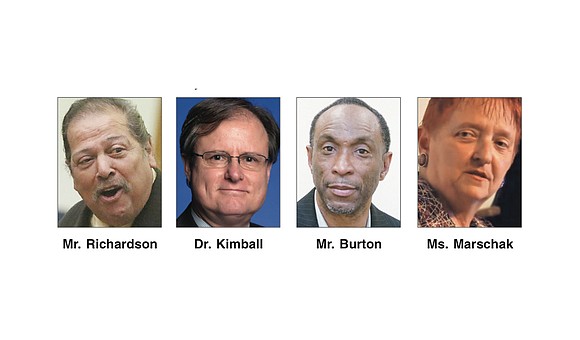Confederate statues must come down, commission told
4/6/2018, 8:04 a.m.
By Saraya Wintersmith
At a raw and emotional meeting last week with members of the Monument Avenue Commission, several speakers told commission members there is no middle ground — the Confederate statues cannot remain on Monument Avenue if the city wants to evolve beyond its racist past.
“People took up arms against the United States of America with the aim of killing the Union and separating into another country,” said Richmond native Gary Flowers, a former national field director with the Rainbow PUSH Coalition and current host of a local radio talk show.
He argued that the Confederate figures will be “a global embarrassment” as Virginia prepares for next year’s commemoration of the 400th anniversary of the arrival of the first Africans in 1619.
“I think we should sell the statues to the (United) Daughters of the Confederacy, the sons of the Confederacy, the nieces of the Confederacy and the cousins of the Confederacy,” Mr. Flowers said to laughter. “Let them set up a tourism park on their dime.”
“Those statues stand for men who fought to make sure that young women continued to be raped,” said former Richmond City Councilman H.W. “Chuck” Richardson. “Those men up there now that we praise … fought for white supremacy and believed in those activities.”
He said the commission members have a “moral obligation” that usurps any hidden political aspirations they might hold to recommend the statues be removed.
“To allow those symbols to remain is to allow good people who know better to be a part of the big lie,” said former Richmond City Councilman Martin E. “Marty” Jewell.
The meeting, held March 29 at Fifth Baptist Church on West Cary Street, was hosted by the Sacred Ground Historical Reclamation Project, a group that has advocated for Confederate monument removal for more than a decade. The group has worked for the preservation of the African Burial Ground on the edge of Shockoe Bottom.
About 30 people attended. It was the fourth in a series of small, community group meetings attended by Monument Avenue Commission members.
Previous community meetings were held by the Richmond Peace Education Center, the Sons of Confederate Veterans and First Unitarian Universalist Church of Richmond to gauge public sentiment about what do to with the city’s public statues dedicated to Confederates.
Initially, Mayor Levar M. Stoney established the commission to determine the best way to add “context” to the statues. He later added removal as an option following the violent and deadly rally by neo-Nazis and white supremacists in Charlottesville last August in support of maintaining that city’s Confederate statues in public parks.
State law bars alteration or removal of war monuments, but because of a pending lawsuit in Charlottesville, it is unclear whether the Confederate statues on Richmond’s Monument Avenue would fall into that protected category. If they do, Richmond City Council would need to request General Assembly permission to remove them, a measure the council rejected on a 6-2 vote in December. Several council members said at the time that they were awaiting the Monument Avenue Commission’s recommendation.
Two City Council members, Kim Gray of the 2nd District and Andreas D. Addison of the 1st District, also serve on the commission.
Speakers at last week’s meeting raised concerns about the inherently political nature of the commission and whether the public engagement process is all for naught.
“It’s like a political merry-go-round,” said Lynetta Thompson, a former chair of the Richmond Branch NAACP, pointing to the City Council and General Assembly. “This is what aggravates the process because it’s like the intent is not sincere.”
Commission co-chair Greg Kimball acknowledged that political considerations could impact the fate of the statues even after the commission completes its work and makes its recommendation, which is expected sometime in May.
But he urged people to not give up on “the political process in terms of what is possible down the road.”
Arthur Burton, founder and director of the Kinfolk Community Empowerment Center, told the commission that his ancestors were slaves at the “Longfield and Hard Time plantations owned by the Burton family in Eastern Henrico.” He said he still maintains the land his family received through a land grant in 1896.
“I want you guys to understand that there are African-American people who are both deeply connected to the Civil War and its heritage,” he said. “As much as those statues 100 years ago defined what this city is, the reality is those statues no longer represent this city, and we need to start the conversation about what statues are going to represent this city for the next 100 years or 200 years.”
The Confederate statues “essentially are a ‘whites only’ sign that’s real big,” said Elizabeth “Beth” Marschak, a board member of Diversity Richmond, who recalled being scolded as a youth for trying to drink from a “coloreds only” water fountain in Downtown.
“I don’t think we would argue that whites only signs should’ve stayed up because they’re history. They needed to come down and maybe go to a museum so people would know what had happened,” she said.
“But as long as they would have been posted in their original sites, people would still give them credence. And that is what is wrong with the statues on Monument Avenue.”
She asked the commission members not to base their recommendation on what is financially or legally possible.
“Legal things can be changed, and if (the statues) are really the valuable things people think they are, somebody will pay to put them somewhere else.”
In addition to Dr. Kimball, director of education and outreach at the Library of Virginia, other commission members attending the meeting were co-chair Christy Coleman, CEO of the American Civil War Museum; University of Richmond professor Lauranett Lee; Coleen Butler Rodriguez, a Monument Avenue resident and home renovator; and advisory member Sarah S. Driggs of the Richmond Public Art Commission.








